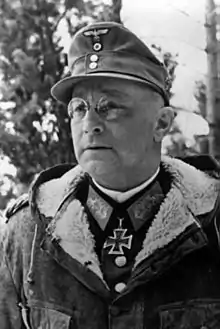Franz Böhme
Franz Friedrich Böhme (15 April 1885 – 29 May 1947) was an Army officer who served in succession with the Austro-Hungarian Army, the Austrian Army and the German Wehrmacht. He rose to the rank of general during World War II, serving as Commander of the XVIII Mountain Corps, Hitler's Plenipotentiary Commanding General (Bevollmächtigter Kommandierender General) in the Balkans, and commander-in-chief in German-occupied Norway during World War II. After the war, Böhme was transferred to U.S. custody as a defendant in the Hostages Trial on charges of having massacred thousands of Serbian civilians. He committed suicide in prison.
Franz Böhme | |
|---|---|
 Franz Böhme in March 1943 | |
| Born | 15 April 1885 Zeltweg, Styria, Austria-Hungary |
| Died | 29 May 1947 (aged 62) Nuremberg, Bavaria, Allied-occupied Germany |
| Buried | |
| Allegiance | |
| Service/ | Austro-Hungarian Army Bundesheer Wehrmacht |
| Years of service | 1900–1938 (Austria) 1938–1945 (Germany) |
| Rank | Generalmajor (Austria) General der Gebirgstruppe (Germany) |
| Commands held | 32nd Infantry Division XVIII Mountain Corps 20th Mountain Army |
| Battles/wars | World War I World War II |
| Awards | Knight's Cross of the Iron Cross |
Life and career
Franz Böhme was born in Zeltweg in Styria, Austria on 15 April 1885. He entered the Austro-Hungarian Army in October 1900 as a cadet and was commissioned as a lieutenant in an infantry regiment in 1905. He served in World War I and remained in the Austrian Bundesheer after 1918, transferring to the Wehrmacht on the Anschluss with Germany in 1938, replacing Austrian Chief of Staff Alfred Jansa.[1]
During the opening years of World War II, Böhme held command of the 30th Infantry Division and 32nd Infantry Division, taking part in the invasion of Poland in September 1939 and in the Battle of France in May and June 1940. On 29 June 1940, he was awarded the Knight's Cross of the Iron Cross.[2]
Between 16 September 1941 and 2 December 1941, as Commanding General and Commander of Serbia, Böhme ordered the reprisal executions of 2,000 civilians in Kragujevac after a partisan assault on 22 soldiers of the 421 Korps-Nachrichten-Abteilung.[3]
In December 1943, Böhme was appointed Deputy Commanding General of the XVIII Corps and Commander of Wehrkreis XVIII, Salzburg. On 4 June 1944, he was delegated with the leadership of the Second Panzer Army in the Balkans with Böhme succeeding Generaloberst Lothar Rendulic.
In July 1944, Böhme was transferred to the Army's High Command Leader Reserve, giving up control of the 2nd Panzer Army to General Maximilian de Angelis. Between 8 January 1945 and 8 May 1945, he was Armed Forces Commander of Norway and Commander-in-Chief of the 20th Mountain Army.[1]
Trial and suicide
After being captured in Norway, he was brought before the Hostages Trial, a division of the Subsequent Nuremberg Trials, and charged with war crimes committed in Serbia during his control of the region in 1941. At that time, he had increased the scale of retaliatory strikes against Serbs, killing a hundred Serbs for every German killed, and fifty for every German wounded; this resulted in the massacre of thousands of civilians.[4] When his extradition to Yugoslavia seemed imminent, Böhme committed suicide by jumping from the 4th story of the prison in which he was being held. His body was interred at St. Leonhard-Friedhof in Graz, Austria.
Awards and decorations
- Iron Cross (1914)
- 2nd Class (1916)
- 1st Class (12 June 1917)
- Iron Cross (1939)
- 2nd Class (12 September 1939)
- 1st Class (25 September 1939)
- Order of the Cross of Liberty 1st Class with Oak leaves and Swords (Finland)
- German Cross in Gold on 10 February 1944 as General der Infanterie in the XVIII. (Gebirgs) Armeekorps[5]
- Knight's Cross of the Iron Cross on 29 June 1940 as Generalleutnant commander of 32. Infanterie-Division[2]
References
Citations
- Lucas 1980, p. 211.
- Fellgiebel 2000, p. 137.
- "Massacres And Reprisals During The German Occupation Of Yugoslavia". Akademediasrbija.com. Archived from the original on 2016-03-05. Retrieved 2016-10-20.
- Weiner, Ofer & Barber 1996, pp. 145–152.
- Patzwall & Scherzer 2001, p. 49.
Bibliography
- Fellgiebel, Walther-Peer (2000) [1986]. Die Träger des Ritterkreuzes des Eisernen Kreuzes 1939–1945 — Die Inhaber der höchsten Auszeichnung des Zweiten Weltkrieges aller Wehrmachtteile [The Bearers of the Knight's Cross of the Iron Cross 1939–1945 — The Owners of the Highest Award of the Second World War of all Wehrmacht Branches] (in German). Friedberg, Germany: Podzun-Pallas. ISBN 978-3-7909-0284-6.
- Lucas, James (1980). Alpine Elite: German Mountain Troops of World War II. Jane's Publishing. ISBN 0531037134.
- Patzwall, Klaus D.; Scherzer, Veit (2001). Das Deutsche Kreuz 1941 – 1945 Geschichte und Inhaber Band II [The German Cross 1941 – 1945 History and Recipients Volume 2] (in German). Norderstedt, Germany: Verlag Klaus D. Patzwall. ISBN 978-3-931533-45-8.
- Scherzer, Veit (2007). Die Ritterkreuzträger 1939–1945 Die Inhaber des Ritterkreuzes des Eisernen Kreuzes 1939 von Heer, Luftwaffe, Kriegsmarine, Waffen-SS, Volkssturm sowie mit Deutschland verbündeter Streitkräfte nach den Unterlagen des Bundesarchives [The Knight's Cross Bearers 1939–1945 The Holders of the Knight's Cross of the Iron Cross 1939 by Army, Air Force, Navy, Waffen-SS, Volkssturm and Allied Forces with Germany According to the Documents of the Federal Archives] (in German). Jena, Germany: Scherzers Militaer-Verlag. ISBN 978-3-938845-17-2.
- Weiner, Hana; Ofer, Dalia; Barber, Anne (1996). Dead-end Journey: the Tragic Story of the Kladovo-Šabac Group. University Press of America. ISBN 0761801995.